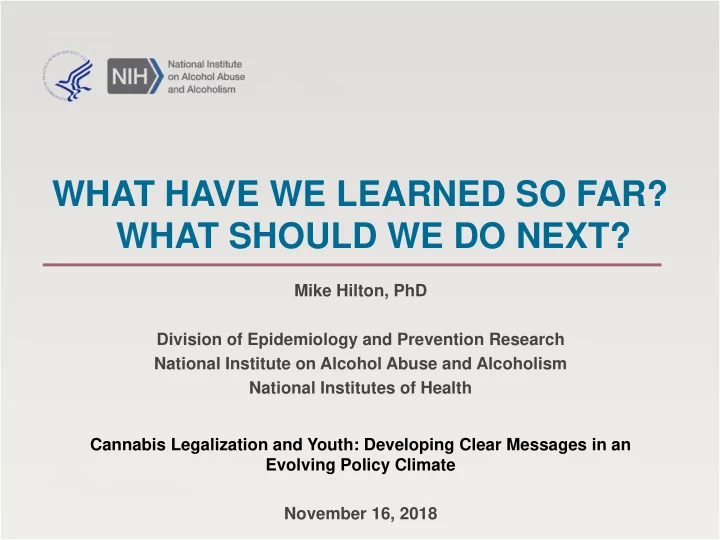

WHAT HAVE WE LEARNED SO FAR? WHAT SHOULD WE DO NEXT? Mike Hilton, PhD Division of Epidemiology and Prevention Research National Institute on Alcohol Abuse and Alcoholism National Institutes of Health Cannabis Legalization and Youth: Developing Clear Messages in an Evolving Policy Climate November 16, 2018
Overview I. Recent findings II. Research tools III. Research opportunities
I. Recent findings
* Rates significantly increased from the previous year at a p value of <0.003 for hospitalizations and >0.0125 for ED visits. †lCD -9-CM codes 305.20 – 305.23, 304.30 – 304.33, 969.6, and E854.1 were used to determine HD and ED visits with marijuana- related billing codes within the first three diagnosis codes. ‡Data source: Colorado Hospital Association Discharge Data Source: Wang et al., Marijuana and acute health contracts in Colorado. Prev Med 104 (2017): 24-30.
*Counts significantly increased from previous year with a p value <0.003. †Unknown age includes calls with ages recorded as teens, 20s, unknown adult (≥20 yrs ), unknown child (≤19 yrs), and unknown age. ‡Human marijuana exposure calls to RPC were determined by the presence of the generic code Marijuana - 0083000 from the National Poison Data System or marijuana exposure mentioned in RPC case notes. Source: Wang et al., Marijuana and acute health contracts in Colorado. Prev Med 104 (2017): 24-30.
“Models including indicators of medical and recreational marijuana policies did not find any significant positive impacts”
Any marijuana use in past 30 days: Change between 2010-2011 (before) and 2013-2015 (after) 8 th 10 th 12 th graders graders graders Washington 2.0% 4.1% NS Colorado NS NS NS Source: Cerda et al., Association of State Recreational Marijuana Laws With Adolescent Marijuana Use. JAMA Pediatrics 171(2): 142-149
Annual Year-Over-Year Changes in Motor Vehicle Crash Fatality Rates per Billion Vehicle Miles Traveled (BVMT) Before and After Recreational Marijuana Legalization (RML): Washington (WA), Colorado (CO), and 8 Control States, 2010 – 2015 “Three years after recreational marijuana legalization, changes in motor vehicle crash fatality rates for Washington and Colorado were not statistically different from those in similar states without recreational marijuana legalization.” Source: Aydelotte et al., Crash fatality rates after recreational marijuana legalization in Washington and Colorado, Am J Pub Health 107:1329 – 1331, 2017.
Marijuana-Related Traffic Fatalities per billion VMT Colorado Washington Source: Hansen et al. Early evidence on recreational marijuana legalization and traffic fatalities. National Bureau of Economic Research Working Paper 24417, 2018.
Findings so Far • Sparse • Mixed • Early Stage
Obstacles Encountered • Policy formulation and policy research timelines do not match • There is no standard measure of quantity
“Explore the possibility of constructing a standardized dose similar to that for alcohol {the standard drink), tobacco (a cigarette), or opioids...”
Obstacles Encountered • Policy formulation and policy research timelines do not match • There is no standard measure of quantity • There is no defensible standard for per se driving impairment
“[D] etermining an appropriate THC concentration for a legal per se limit or zero tolerance concentration, based on a laboratory’s methodological limit of quantification, is an urgent international priority.” “Unfortunately, there is no one THC blood concentration that will achieve this goal…”
Recap • What have we learned so far? o Not much o There are significant obstacles • Research tools • Research opportunities
II. Research Tools
Features covered by APIS • Regulatory agency • Products permitted • Maximum amount cultivated • Retail sales conditions • Pricing controls • Taxation • Underage prohibitions • Impaired driving • Local authority
Features covered by PDAPS • Regulatory agency • Minimum age • Product testing • Out of state residents • Amount purchased or possessed • Number of plants possessed • Impaired driving • License to cultivate • Retail licenses • Taxation
Main Takeaway
III. Research Opportunities
Thank you! Mike Hilton mhilton@mail.nih.gov
Recommend
More recommend